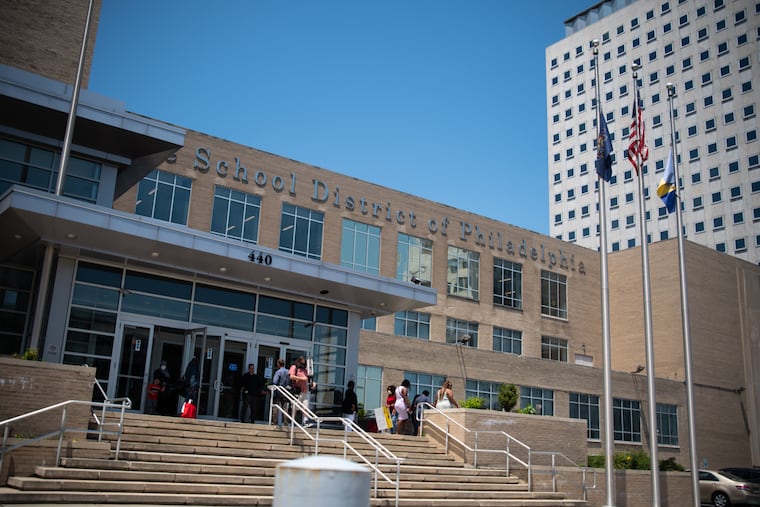Philly schools tops in big-city U.S. districts in academic recovery: takeaways from the school board meeting
Measured against other large, poor urban districts, Philadelphia approached its pre-pandemic math achievement faster than any other city’s schools.

Philadelphia schools had the strongest academic recovery among large urban districts, according to a new research study, and generally, math performance for third through eighth graders is improving across the district.
Those were the top takeaways from the school board’s “Goals and Guardrails” meeting Thursday night, a session not for voting but for monitoring academic progress in the district of 113,000 students.
Here are the highlights from the meeting:
We’re number one!
According to the Education Recovery Scorecard, a research project out of Harvard and Stanford Universities, Philadelphia is recovering from the pandemic faster than other large city school systems — as well as other districts in Pennsylvania.
Measured against other large, poor urban districts, Philadelphia approached its pre-pandemic math achievement faster than any other city’s schools, with students recovering almost half a grade of learning during the 2022-23 school year. Los Angeles schools were just behind Philadelphia.
In reading, the district bested its pre-pandemic levels and showed more growth than similar districts — only Chicago public schools grew faster.
Examining the district against other schools in the commonwealth, Philadelphia is closer than any of its peer districts — Pittsburgh, Bethlehem, Erie, Scranton and Wilkes-Barre — to pre-pandemic math performance, and above pre-pandemic reading levels compared to those same districts. It also bested the state growth in reading and math.
“This is really significant for our students,” said Superintendent Tony B. Watlington Sr.
“The School District of Philadelphia is almost back to pre-pandemic levels,” said Tonya Wolford, the district’s chief of evaluation, research and accountability.
Still, Philadelphia had and has a long way to go. District students’ achievement ranks near the bottom of all big-city school districts as measured by the only exam given to schools nationally.
But, Watlington said, progress matters, even if the starting point is low.
“Any time the School District of Philadelphia can get in first place in terms of rebound and improvement, we should celebrate and applaud our students and staff and say, well we’re on the right track … and yet we have a long way to go and a lot of work to do,” Watlington told the board. “We need to let our teachers and our students know that success begets more success.”
Monitoring math
District staff and the school board spent most of Thursday night’s meeting scrutinizing the district’s third through eighth graders’ progress in math.
Philadelphia students’ math performance jumped in state tests — 20.1% of students met or exceeded standards in 2022-23 as measured by the Pennsylvania System of School Assessment, up from 16.5% the prior year.
District pupils also improved on the Star exam performance, a test students take several times during the year to chart progress. In the winter of 2022-23, 17.4% of students in grades 3 to 8 scored at or above benchmark in math; that jumped to 19.3% this school year. Students posted improvements across racial/ethnic groups.
An additional 30.7% of students were “on watch,” that is, scored in the 25th to 39th percentile. Districtwide, 17.6% of students needed strategic interventions, scoring in the 10th to 24th percentile. The largest group of students districtwide landed in the lowest category, “intensive intervention,” meaning they scored below 10%.
Though students in kindergarten through second grade do not take state tests, their progress is charted by Star math. Philadelphia’s K-2 students saw increases in performance by every curriculum-based measure — concepts like numeral recognition, quantity comparison, addition to 10 and 20 and subtraction from 10, depending on the child’s grade level.
Board vice president Mallory Fix Lopez said the early-grade gains were particularly significant and would “really set us on a pathway for much more sustainable, faster-driving improvement.”
What about the new math curriculum?
Philadelphia is spending $70 million on new math, reading and science curriculum over the next few years; it rolled out the new math curriculum, Illustrative Math, in the fall.
District staff told the board that 83% of district staff who participated in trainings reported they felt prepared to teach the curriculum, though not all staff took part in the trainings.
Teachers told district leadership that generally, they have the materials they need to successfully teach the new math curriculum, but a lack of time is a barrier to implementation.
What does it all mean?
Asked by one board member what the improvements mean, Watlington was emphatic.
The gains show that the district and board “are good stewards of the public’s tax dollars,” the superintendent said. “We are getting a significant return on our investment, even though there’s a lot more work to do. The data tells us that if we invest in highly qualified teachers and principals and we improve student and teacher attendance, we’ll get better.”
Board member Lisa Salley, who often drives home how far the district has to go to reach its goals, said she was impressed.
“This is really exciting to see this information and this data,” Salley said.
President Reginald Streater, father of a fifth grader and a fourth grader who attend C.W. Henry Elementary, a neighborhood public school in Mount Airy, went one step further.
“I’m excited,” Streater said. “I’m giddy with this.”